上外版(2020)选择性必修第三册Unit 4 Protecting the Environment:Critical Thinking课件(共18张PPT)
文档属性
| 名称 | 上外版(2020)选择性必修第三册Unit 4 Protecting the Environment:Critical Thinking课件(共18张PPT) | 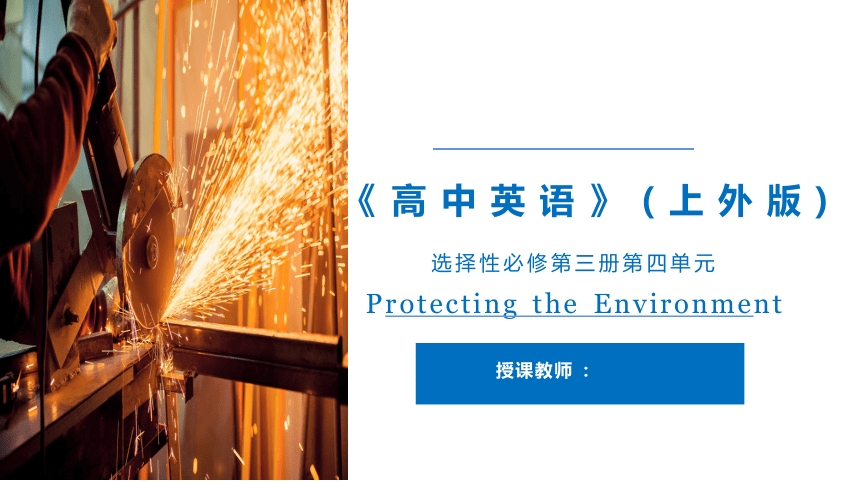 | |
| 格式 | pptx | ||
| 文件大小 | 2.9MB | ||
| 资源类型 | 教案 | ||
| 版本资源 | 上外版(2020) | ||
| 科目 | 英语 | ||
| 更新时间 | 2024-09-08 18:22:42 | ||
图片预览

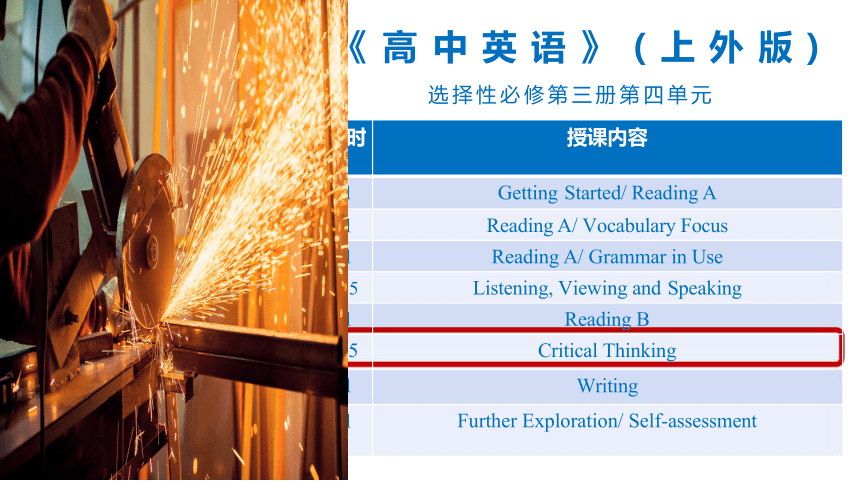
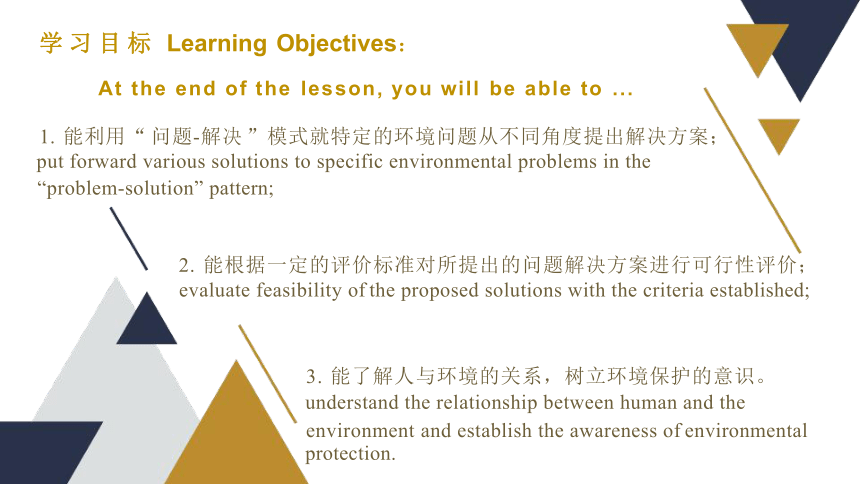
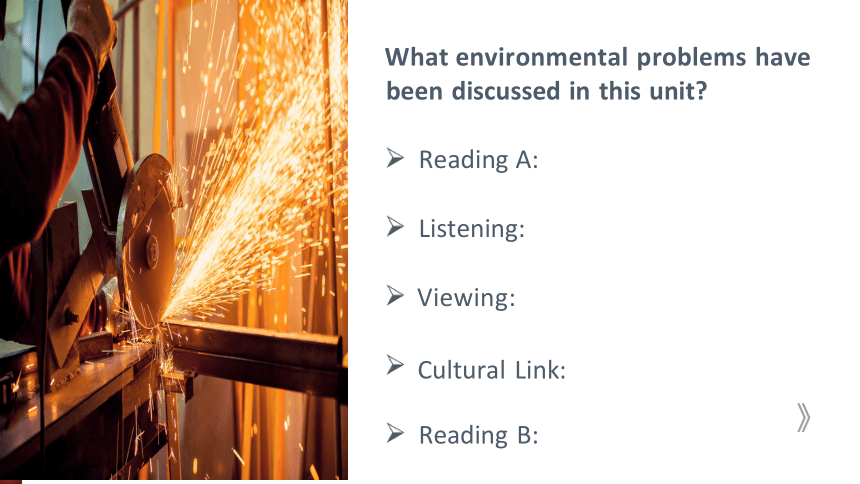
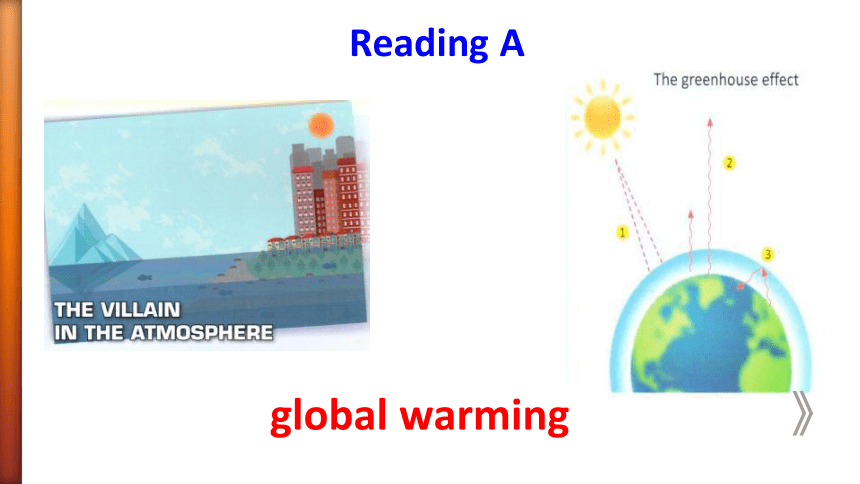
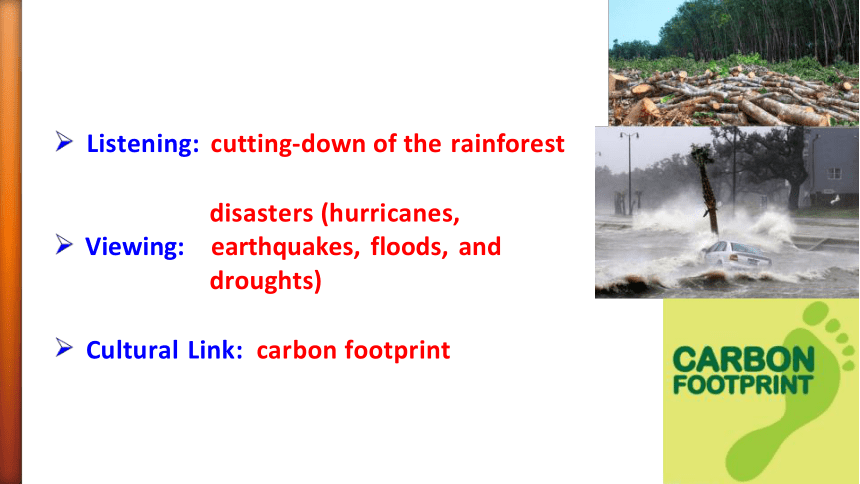
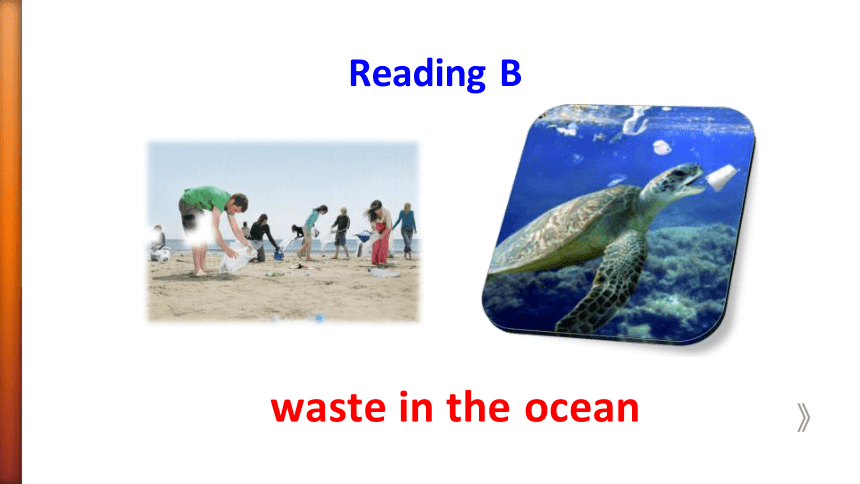
文档简介
(共18张PPT)
《 高 中 英 语 》 ( 上 外 版 )
选择性必修第三册第四单元
Protecting the Environment
授课教师 :
课时
授课内容
1
Getting Started/ Reading A
1
Reading A/ Vocabulary Focus
1
Reading A/ Grammar in Use
1.5
Listening, Viewing and Speaking
1
Reading B
0.5
Critical Thinking
1
Writing
1
Further Exploration/ Self-assessment
《 高 中 英 语 》 ( 上 外 版 )
选择性必修第三册第四单元
学习目标 Learning Objectives:
At the end of the lesson, you will be able to ...
1. 能利用“ 问题-解决 ”模式就特定的环境问题从不同角度提出解决方案; put forward various solutions to specific environmental problems in the
“problem-solution” pattern;
2. 能根据一定的评价标准对所提出的问题解决方案进行可行性评价; evaluate feasibility of the proposed solutions with the criteria established;
3. 能了解人与环境的关系,树立环境保护的意识。
understand the relationship between human and the
environment and establish the awareness of environmental protection.
been discussed in this unit
Reading A:
Listening:
Viewing:
Cultural Link:
Reading B:
What environmental problems have
》
global warming 》
Reading A
》
Listening: cutting-down of the rainforest
disasters (hurricanes,
Viewing: earthquakes, floods, and droughts)
Cultural Link: carbon footprint
waste in the ocean
Reading B
》
For individuals:
1) Individuals should use less packaging and pay attention to where they throw away the rubbish.
2) Individuals can also take part in ocean clean-up day.
Expected results:
1) Less packaging and fewer products are a step on the way to more sustainable development.
2) If rubbish is picked up from the beach, it will not flow out to the ocean and
cause problems for animals that eat it or become trapped in it.
For organisations:
Organisations like Ocean
Conservancy have organised
International Coastal Clean-up.
Expected result: By cleaning up rubbish you are protecting the ocean environment and
the animals that live there.
Solution 2
Solution 1
Are the solutions feasible
The Criteria for the Feasibility of a Solution
□ Is the cost of time, money or energy within a reasonable range
□ Can it be done in practice
□ Will it be effective
…
How can we evaluate the feasibility of a solution
》
For individuals:
1) Individuals should use less packaging and pay attention to where they throw away the rubbish.
2) Individuals can also take part in ocean clean-up day.
Expected results:
1) Less packaging and fewer products are a step on the way to more sustainable development.
2) If rubbish is picked up from the beach, it will not flow out to the ocean and
cause problems for animals that eat it or become trapped in it.
For organisations:
Organisations like Ocean
Conservancy have organised
International Coastal Clean-up.
Expected result: By cleaning up rubbish you are protecting the ocean environment and
the animals that live there.
Solution 2
Solution 1
For organisations:
Expected result:
Solution 2
Problem: Global warming
Consequences of the problem:
↓ Solutions to the problem ↓
》
Conclusion:
For individuals:
Expected results:
Complete the diagram about the problem of global warming.
Solution 1
Problem with the earth
The Criteria for the Feasibility of a Solution
□ Is the cost of time, money or energy within a reasonable range
□ Can it be done in practice
□ Will it be effective
… 》
Solutions Expected results
My
comments
Critical thinking
Present ideas and make comments on the feasibility of the solutions based on the criteria.
Problem: Global warming
Consequences of the problem:
Global warming increases the possibility of extreme weather
events, accelerates the melting of ice caps and the rise of sea level, etc.
√
a
√
√
√
e
h
Problem with the earth
f
For organisations:
1) Organizations like China Environmental Protection Foundation have organised “Automotive Environmental Innovation Leadership Program”.
Expected Result: By this program, more eco-friendly cars will be developed.
2) Ant Financial Service Group has launched Ant Forest program.
Expected result: Ant Forest has motivated a half-billion people to jointly
protect the environment by turning their green deeds into an afforestation campaign.
Solution 1
For individuals:
1) Individuals can reduce waste by choosing reusable products instead of disposables.
Expected result: By recycling, you can save the resources.
2) You can reduce the use of electricity, water and gas, like taking public transportation instead of private cars.
Expected result: By reducing the use of electricity, water and gas, you can save energy and reduce greenhouse gas emission.
Solution 2
If we all make efforts to reduce greenhouse gas Conclusion: emission, global warming will be slowed down
and the environment will be more pleasant.
》
Person by person, family by family,
community by community,
together, we, can make a
difference to the environment.
Homework:
Analyse another environmental problem in the “ problem-solution” pattern by completing the diagram in the worksheet.
》
T h a n k y o u !
《 高 中 英 语 》 ( 上 外 版 )
选择性必修第三册第四单元
Protecting the Environment
授课教师 :
课时
授课内容
1
Getting Started/ Reading A
1
Reading A/ Vocabulary Focus
1
Reading A/ Grammar in Use
1.5
Listening, Viewing and Speaking
1
Reading B
0.5
Critical Thinking
1
Writing
1
Further Exploration/ Self-assessment
《 高 中 英 语 》 ( 上 外 版 )
选择性必修第三册第四单元
学习目标 Learning Objectives:
At the end of the lesson, you will be able to ...
1. 能利用“ 问题-解决 ”模式就特定的环境问题从不同角度提出解决方案; put forward various solutions to specific environmental problems in the
“problem-solution” pattern;
2. 能根据一定的评价标准对所提出的问题解决方案进行可行性评价; evaluate feasibility of the proposed solutions with the criteria established;
3. 能了解人与环境的关系,树立环境保护的意识。
understand the relationship between human and the
environment and establish the awareness of environmental protection.
been discussed in this unit
Reading A:
Listening:
Viewing:
Cultural Link:
Reading B:
What environmental problems have
》
global warming 》
Reading A
》
Listening: cutting-down of the rainforest
disasters (hurricanes,
Viewing: earthquakes, floods, and droughts)
Cultural Link: carbon footprint
waste in the ocean
Reading B
》
For individuals:
1) Individuals should use less packaging and pay attention to where they throw away the rubbish.
2) Individuals can also take part in ocean clean-up day.
Expected results:
1) Less packaging and fewer products are a step on the way to more sustainable development.
2) If rubbish is picked up from the beach, it will not flow out to the ocean and
cause problems for animals that eat it or become trapped in it.
For organisations:
Organisations like Ocean
Conservancy have organised
International Coastal Clean-up.
Expected result: By cleaning up rubbish you are protecting the ocean environment and
the animals that live there.
Solution 2
Solution 1
Are the solutions feasible
The Criteria for the Feasibility of a Solution
□ Is the cost of time, money or energy within a reasonable range
□ Can it be done in practice
□ Will it be effective
…
How can we evaluate the feasibility of a solution
》
For individuals:
1) Individuals should use less packaging and pay attention to where they throw away the rubbish.
2) Individuals can also take part in ocean clean-up day.
Expected results:
1) Less packaging and fewer products are a step on the way to more sustainable development.
2) If rubbish is picked up from the beach, it will not flow out to the ocean and
cause problems for animals that eat it or become trapped in it.
For organisations:
Organisations like Ocean
Conservancy have organised
International Coastal Clean-up.
Expected result: By cleaning up rubbish you are protecting the ocean environment and
the animals that live there.
Solution 2
Solution 1
For organisations:
Expected result:
Solution 2
Problem: Global warming
Consequences of the problem:
↓ Solutions to the problem ↓
》
Conclusion:
For individuals:
Expected results:
Complete the diagram about the problem of global warming.
Solution 1
Problem with the earth
The Criteria for the Feasibility of a Solution
□ Is the cost of time, money or energy within a reasonable range
□ Can it be done in practice
□ Will it be effective
… 》
Solutions Expected results
My
comments
Critical thinking
Present ideas and make comments on the feasibility of the solutions based on the criteria.
Problem: Global warming
Consequences of the problem:
Global warming increases the possibility of extreme weather
events, accelerates the melting of ice caps and the rise of sea level, etc.
√
a
√
√
√
e
h
Problem with the earth
f
For organisations:
1) Organizations like China Environmental Protection Foundation have organised “Automotive Environmental Innovation Leadership Program”.
Expected Result: By this program, more eco-friendly cars will be developed.
2) Ant Financial Service Group has launched Ant Forest program.
Expected result: Ant Forest has motivated a half-billion people to jointly
protect the environment by turning their green deeds into an afforestation campaign.
Solution 1
For individuals:
1) Individuals can reduce waste by choosing reusable products instead of disposables.
Expected result: By recycling, you can save the resources.
2) You can reduce the use of electricity, water and gas, like taking public transportation instead of private cars.
Expected result: By reducing the use of electricity, water and gas, you can save energy and reduce greenhouse gas emission.
Solution 2
If we all make efforts to reduce greenhouse gas Conclusion: emission, global warming will be slowed down
and the environment will be more pleasant.
》
Person by person, family by family,
community by community,
together, we, can make a
difference to the environment.
Homework:
Analyse another environmental problem in the “ problem-solution” pattern by completing the diagram in the worksheet.
》
T h a n k y o u !
同课章节目录
